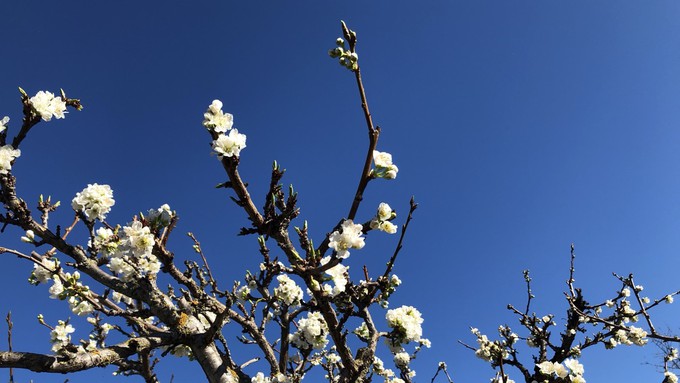
Sacramento master gardeners will be on hand to offer advice and tips

The forecast for Saturday is clear and cold, with an excellent chance of fruit tree blossoms at the Fair Oaks Horticulture Center. Kathy Morrison
After the recent stormy weather, gardeners and gardening hopefuls are likely to be anxious to get outside. This Saturday, Feb. 10, should offer the perfect opportunity, as the Fair Oaks Horticulture Center welcomes visitors to Open Garden Day.
The free, informal event, which runs from 9 a.m. to noon, features Sacramento County master gardeners working in the various areas of the Horticulture Center. As visitors stroll through the site, they are encouraged to chat with the master gardeners, ask gardening questions and gather ideas for their own gardens.
The FOHC includes a vineyard, an orchard (including a separate citrus area), an herb garden, vegetable area, a berry garden, composting area and an extensive Water-Efficient Landscape, which features California natives and other plants appropriate for the Sacramento region. The WEL is open every day during daylight hours, but the other areas are open to the public only during Open Garden Days and Harvest Day.
The "Ask a Master Gardener" table will be staffed to evaluate gardening mysteries and view examples of garden problems (leaves, insects and the like -- preferably transported in sealed clear bags).
The master gardeners also will be selling their 2024 Gardening Guide and Calendar, an invaluable resource with a price tag of just $12. It includes planting charts and lists of monthly garden tasks, as well as a wealth of information on creating a wildlife habitat in a home garden.
Mini talks are planned in the different areas of the Horticulture Center during the morning; check the schedule at the entrance for times and topics.
The Fair Oaks Horticulture Center is at 11549 Fair Oaks Blvd., just south of Fair Oaks Park at Madison Avenue and Fair Oaks. Parking is free.
Open Gardens are typically on Saturday mornings, but a few each year are on different days to accommodate other schedules. The remaining winter and spring ones this year are set for March 16, April 17 (a Wednesday), May 11, June 6 (Thursday evening) and June 15. Harvest Day, which is a larger event, is planned for Aug. 3. The year's final Open Gardens will be Sept. 14 and Oct. 16.
For more information on Sacramento County maser gardener activities and events, visit sacmg.ucanr.edu.
Comments
0 comments have been posted.Sacramento Digs Gardening to your inbox.
Food in My Back Yard Series
May 6: Maintain soil moisture with mulch for garden success
April 29: What's (already) wrong with my tomato plants?
April 22: Should you stock up on fertilizer? (Yes!)
April 15: Grow culinary herbs in containers
April 8: When to plant summer vegetables
April 1: Don't be fooled by these garden myths
March 25: Fertilizer tips: How to 'feed' your vegetables for healthy growth
March 18: Time to give vegetable seedlings some more space
March 11: Ways to win the fight against weeds
March 4: Potatoes from the garden
Feb. 25: Plant a fruit tree now -- for later
Feb. 18: How to squeeze more food into less space
Feb. 11: When to plant? Consider staggering your transplants
Feb. 4: Starting in seed starting
Sites We Like
Garden Checklist for week of May 4
Enjoy this spring weather – and get gardening!
* Plant, plant, plant! It’s prime planting season in the Sacramento area. Time to set out those tomato transplants along with peppers and eggplants. Pinch off any flowers on new transplants to make them concentrate on establishing roots instead of setting premature fruit.
* Direct-seed melons, cucumbers, summer squash, corn, radishes, pumpkins and annual herbs such as basil.
* Harvest cabbage, lettuce, peas and green onions.
* In the flower garden, direct-seed sunflowers, cosmos, salvia, zinnias, marigolds, celosia and asters. (You also can transplant seedlings for many of the same flowers.)
* Plant dahlia tubers. Other perennials to set out include verbena, coreopsis, coneflower and astilbe.
* Transplant petunias, marigolds and perennial flowers such as astilbe, columbine, coneflowers, coreopsis, dahlias, rudbeckia and verbena.
* Keep an eye out for slugs, snails, earwigs and aphids that want to dine on tender new growth.
* Feed summer bloomers with a balanced fertilizer.
* For continued bloom, cut off spent flowers on roses as well as other flowering plants.
* Add mulch to the garden to maintain moisture. Mulch also cuts down on weeds. But don’t let it mound around the stems or trunks of trees or shrubs. Leave about a 6-inch to 1-foot circle to avoid crown rot or other problems.